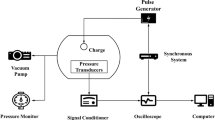Abstract
A model of shock-wave heating of condensed high-explosives (HE) in which a refined dependence of the heat capacity of an HE on temperature is used and the effect of the initial density of the HE is taken into account is given. The dependences of HE (TNT, PETN, and TATB) heating on pressure in the shock-wave front are calculated. Modeling of TATB heating is of interest for understanding the shock-wave detonation initiation, including the dependence of the shock-wave sensitivity on the initial density and temperature of an HE.
Similar content being viewed by others
References
R. Jackson, L. Green, R. Barlett, et al., “Specific features of the initiation and propagation of detonation in an explosive TATB,” in:Detonation and Explosives [Russian translation], Mir, Moscow (1981), pp. 323–342. [Proc. of 6th Symp. (Int.) on Detonation, California, August 24–27, 1976.]
R. Chaiken, “Correlation between the pressure and temperature of shock compression and the delay time of detonation in nitromethane,”ibid., in:, pp. 220–235. (Symp. H.D.P, Paris, Aug. 27–31, 1978.)
G. I. Kanel’, S. V. Razorenov, A. V. Utkin, and V. E. Fortov (eds.),Shock-Wave Phenomena in Condensed Media [in Russian], Yanus-K, Moscow (1996).
M. Cowperthwaite and R. Shaw, “Cv(T) equation of state for liquids. Calculation of the shock temperature of carbon tetrachloride, nitromethane, and water in 100-kbar region,”J. Chem. Phys.,53, No. 4, 555–560 (1970).
P. J. Miller, S. Block, and G. J. Piermarini, “Effect of pressure on the vibration spectra of liquid nitromethane,”J. Phys. Chem.,93, 462–466 (1989).
M. V. Vol’kenshtein,Structure and Physical Properties of Molecules [in Russian], Izd. Akad. Nauk SSSR, Moscow (1955).
Tsan Hsu-sen,Physical Mechanics [Russian translation], Mir, Moscow (1965).
T. Clark,A Handbook of Computational Chemistry, Wilew, New York (1985).
I. M. Voskoboinikov and V. M. Bogomolov, “Temperature measurements of shock-compressed CCl4 and a CCl4-C6H6 solution,”Pis’ma Zh. Éksp. Teor. Fiz.,7, No. 9, 338–341 (1968).
M. F. Gogulya and A. Yu. Dolgoborodov, “Indicator method of studying shock and detonation waves,”Khim. Fiz.,13, No. 2, 118–127 (1994).
B. Olinger and H. Cady, “Shock compressibility of PETN, TATB, CO2, and H2O at pressures of up to 10 GPa,” in:Detonation and Explosives [Russian translation], Mir, Moscow (1981), pp. 203–219. [Proc. of 6th Symp. (Int.) on Detonation, California, August 24–27, 1976.]
I. I. Voskoboinikov, V. M. Bogomolov, and A. Ya. Apin, “Calculation of the initiation pressure of an explosion of homogeneous explosives by a shock wave,”Fiz. Goreniya Vzryva,4, No. 1, 45–49 (1968).
C. Mader,Numerical Modeling of Detonations, Univ. of California Press, Berkeley-Los Angeles-London (1979).
I. M. Voskoboinikov and N. F. Voskoboinikova, “Measurement of the conversion times of condensed explosives in a detonation wave,”Khim. Fiz.,7, No. 3, 406–411 (1988).
E. I. Zababakhin,Some Problems of Explosion Gas Dynamics [in Russian], Snezhinsk (1997).
S. M. Tarver, P. A. Urtiev, and W. C. Tao, “Effect of tandem and colliding shock waves on the initiation of triaminotrinitrobenzene,”J. Appl. Phys.,78, No. 5, 3089–3095 (1995).
Author information
Authors and Affiliations
Additional information
Translated fromFizika Goreniya i Vzryva, Vol. 36, No. 2, pp. 94–99, March–April, 2000.
Rights and permissions
About this article
Cite this article
Grebenkin, K.F., Zherebtsov, A.L. Numerical modeling of TATB shock-wave heating. Combust Explos Shock Waves 36, 246–251 (2000). https://doi.org/10.1007/BF02699369
Received:
Revised:
Issue Date:
DOI: https://doi.org/10.1007/BF02699369




